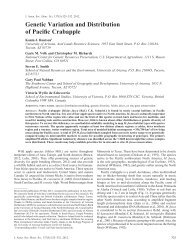CONSERVATION
Conservation You Can Taste - The Southwest Center - University of ...
Conservation You Can Taste - The Southwest Center - University of ...
- No tags were found...
Create successful ePaper yourself
Turn your PDF publications into a flip-book with our unique Google optimized e-Paper software.
WHITE SONORA WHEAT:<br />
Adding Heritage Grains into the Local Foods Mix<br />
Natalie Rachel Morris with Emma Zimmerman,<br />
Marco Bianco and Chris Schmidt<br />
WHEAT seems to be everywhere, but very little<br />
heritage wheat or other locally-produced grains have<br />
made it into relocalized food systems. Compared to<br />
the astounding successes in the recovery of heirloom<br />
vegetables and fruits as well as heritage livestock<br />
and poultry, the production and acceptance of<br />
heritage grains have lagged far behind. At the same<br />
time, the number of consumers concerned and<br />
perhaps sickened by cereals high in gluten but low<br />
in nutritional value seems to be growing.<br />
White Sonora wheat, one of the oldest soft<br />
white bread wheat varieties introduced to the<br />
Americas, stands on its own for its unique flavor,<br />
texture, unusual culinary applications and arid land<br />
adaptations. Since its introduction to what is now<br />
known as the U.S./Mexico border states in 1640<br />
it has been dry-farmed or grown with rainwater<br />
harvesting techniques that use at least a quarter less<br />
water per season than required for most modern<br />
hybrid wheats.<br />
After centuries of being the primary bread wheat<br />
grown in northern Mexico and the American West,<br />
its production began to decline around World War<br />
II. Fortunately, those who care about culinary quality<br />
and aesthetics have been vindicated, for White<br />
Sonora has been recently revived and is getting rave<br />
reviews from pastry chefs, artisanal millers, bakers<br />
and micro-brewers. As such, this ancient wheat<br />
has suddenly become a game-changer, teacher and<br />
agent for stimulating innovation across the entire<br />
food supply chain, particularly in northern California<br />
and southern Arizona.<br />
Jeff and Emma Zimmerman are the father/<br />
daughter team that own and manage the recently<br />
reestablished Hayden Flour Mills in Phoenix,<br />
Arizona. They have been pivotal in creating a<br />
collaborative network of producers, researchers,<br />
millers, marketers, bakers, chefs and consumers<br />
enthusiastic about not only the White Sonora wheat,<br />
but also heritage grains in general.<br />
As Emma reminds us, “Heritage grains from<br />
the pre-industrial era have qualities that artisanal<br />
millers seek. And because White Sonora wheat is so<br />
arid-adapted, it makes sense to grow it in Arizona.<br />
The taste is special too. Chefs often comment on its<br />
sweetness and creamy color.”<br />
Two of the community enthusiasts wrote a<br />
collaborative grant for the SDA’s Western SARE<br />
program in 2011 that helped the Zimmermans<br />
coordinate the development of the heritage grain<br />
20



